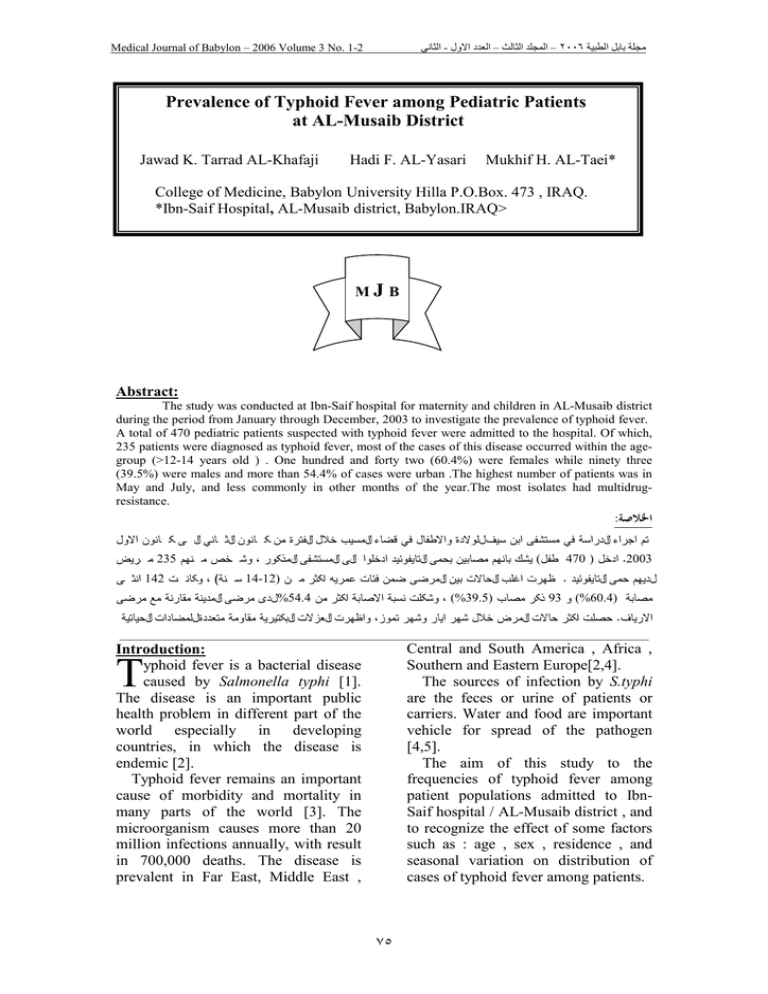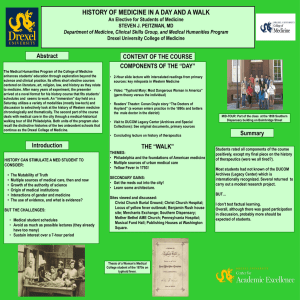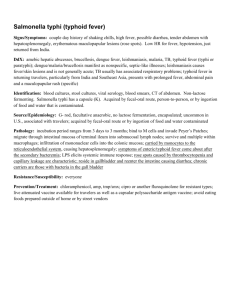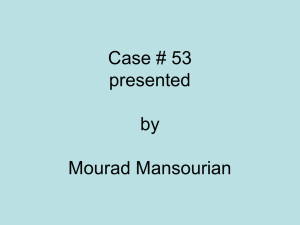Document 12454550
advertisement

ا- – ا ا – اد اول٢٠٠٦ ا Medical Journal of Babylon – 2006 Volume 3 No. 1-2 Prevalence of Typhoid Fever among Pediatric Patients at AL-Musaib District Jawad K. Tarrad AL-Khafaji Hadi F. AL-Yasari Mukhif H. AL-Taei* College of Medicine, Babylon University Hilla P.O.Box. 473 , IRAQ. *Ibn-Saif Hospital, AL-Musaib district, Babylon.IRAQ> MJ B Abstract: The study was conducted at Ibn-Saif hospital for maternity and children in AL-Musaib district during the period from January through December, 2003 to investigate the prevalence of typhoid fever. A total of 470 pediatric patients suspected with typhoid fever were admitted to the hospital. Of which, 235 patients were diagnosed as typhoid fever, most of the cases of this disease occurred within the agegroup (>12-14 years old ) . One hundred and forty two (60.4%) were females while ninety three (39.5%) were males and more than 54.4% of cases were urban .The highest number of patients was in May and July, and less commonly in other months of the year.The most isolates had multidrugresistance. :ﺍﳋﻼﺻﺔ ﺘﻡ ﺍﺠﺭﺍﺀ ﺍﻝﺩﺭﺍﺴﺔ ﻓﻲ ﻤﺴﺘﺸﻔﻰ ﺍﺒﻥ ﺴﻴﻑ ﻝﻠﻭﻻﺩﺓ ﻭﺍﻻﻁﻔﺎل ﻓﻲ ﻗﻀﺎﺀ ﺍﻝﻤﺴﻴﺏ ﺨﻼل ﺍﻝﻔﺘﺭﺓ ﻤﻥ ﻜـﺎﻨﻭﻥ ﺍﻝﺜـﺎﻨﻲ ﺍﻝـﻰ ﻜـﺎﻨﻭﻥ ﺍﻻﻭل ﻤـﺭﻴﺽ235 ﻭﺸـﺨﺹ ﻤـﻨﻬﻡ، ﻁﻔل( ﻴﺸﻙ ﺒﺎﻨﻬﻡ ﻤﺼﺎﺒﻴﻥ ﺒﺤﻤﻰ ﺍﻝﺘﺎﻴﻔﻭﺌﻴﺩ ﺍﺩﺨﻠﻭﺍ ﺍﻝﻰ ﺍﻝﻤﺴﺘﺸﻔﻰ ﺍﻝﻤﺫﻜﻭﺭ470 ) ﺍﺩﺨل.2003 ﺍﻨﺜـﻰ142 ﻭﻜﺎﻨـﺕ، ( ﺴـﻨﺔ14-12) ﻅﻬﺭﺕ ﺍﻏﻠﺏ ﺍﻝﺤﺎﻻﺕ ﺒﻴﻥ ﺍﻝﻤﺭﻀﻰ ﻀﻤﻥ ﻓﺌﺎﺕ ﻋﻤﺭﻴﻪ ﺍﻜﺜﺭ ﻤـﻥ. ﻝﺩﻴﻬﻡ ﺤﻤﻰ ﺍﻝﺘﺎﻴﻔﻭﺌﻴﺩ ﻝﺩﻯ ﻤﺭﻀﻰ ﺍﻝﻤﺩﻴﻨﺔ ﻤﻘﺎﺭﻨﺔ ﻤﻊ ﻤﺭﻀﻰ%54.4 ﻭﺸﻜﻠﺕ ﻨﺴﺒﺔ ﺍﻻﺼﺎﺒﺔ ﺍﻜﺜﺭ ﻤﻥ، (%39.5) ﺫﻜﺭ ﻤﺼﺎﺏ93 ( ﻭ%60.4) ﻤﺼﺎﺒﺔ ﻭﺍﻅﻬﺭﺕ ﺍﻝﻌﺯﻻﺕ ﺍﻝﺒﻜﺘﻴﺭﻴﺔ ﻤﻘﺎﻭﻤﺔ ﻤﺘﻌﺩﺩﺓ ﻝﻠﻤﻀﺎﺩﺍﺕ ﺍﻝﺤﻴﺎﺘﻴﺔ، ﺤﺼﻠﺕ ﺍﻜﺜﺭ ﺤﺎﻻﺕ ﺍﻝﻤﺭﺽ ﺨﻼل ﺸﻬﺭ ﺍﻴﺎﺭ ﻭﺸﻬﺭ ﺘﻤﻭﺯ.ﺍﻻﺭﻴﺎﻑ __________________________________________________________________________________ Central and South America , Africa , Southern and Eastern Europe[2,4]. The sources of infection by S.typhi are the feces or urine of patients or carriers. Water and food are important vehicle for spread of the pathogen [4,5]. The aim of this study to the frequencies of typhoid fever among patient populations admitted to IbnSaif hospital / AL-Musaib district , and to recognize the effect of some factors such as : age , sex , residence , and seasonal variation on distribution of cases of typhoid fever among patients. Introduction: yphoid fever is a bacterial disease caused by Salmonella typhi [1]. The disease is an important public health problem in different part of the world especially in developing countries, in which the disease is endemic [2]. Typhoid fever remains an important cause of morbidity and mortality in many parts of the world [3]. The microorganism causes more than 20 million infections annually, with result in 700,000 deaths. The disease is prevalent in Far East, Middle East , T ٧٥ ا- – ا ا – اد اول٢٠٠٦ ا Medical Journal of Babylon – 2006 Volume 3 No. 1-2 ,Ampicillin (SDI , Iraq) , Amoxicillin (Lilley , Germany) , Penicillin (APM, Jordan) , Tetracycline (SDI,Iraq) , Ciprofloxacin (KBI, Germany) , Trimethprime (Panpharma , France) ,Amoxiclave (Roussel , UK) , Cefotaxime (Panpharma , France) . The disc diffusion of these antibiotic agents were determined by standard method which recommended in the National Committee for Clinical of Laboratory Standards (NCCLS) [9] . Risk factors Some host factors such as: Age groups, sex , residence and month incidence were studied in this study by questionnaire. Materials and Methods: The study was conducted at Ibn-Saif hospital for maternity and children in AL-Musaib district, Babylon governorate during the period from January to December 2003. Numbers of patients were admitted to medical units about 470 suspected with typhoid fever. Hematological investigations: Total leucocytes count and differential leucocytes count were done [ 6 ]. Bacteriological investigations: Different specimens (blood, stool, and urine) were collected from the patients who underlying disease are shown in table-1.The diagnosis was based on bacteriological examinations such as: Gram stain and bacterial cultures, and identified by biochemical tests for each isolates[7]. Antigenic detection: Widal test was performed by using salmonella suspension obtained from Burroughs and Welcome (England) . The test was carried out for flagellar (H) and somatic (O) antibody of typhoid fever [ 8 ]. Antibiotic susceptibility test Isolates were tested for susceptibility to nine different antibiotic agents include : Chloramphenicol (SDI , Iraq) Results: A total , four-hundred seventy specimens collected from patients with suspected typhoid fever were admitted to Ibn-Saif hospital.,235 patients were diagnosed with typhoid fever, 98 isolates(41.7%) recovered from blood of patients , 107 isolates(45.5%) recovered by stool culture and 30 isolates(12.7%) were recovered from urine culture. The table-1 shows numbers and types of clinical specimens for isolation of Salmonella typhi . Table 1 : Sources and numbers of Salmonella typhi isolates. Sources and No.of specimens isolates percentage Blood (201) 98 41.7 Stool (200) 107 45.5 Urine (69) 30 12.7 Total (470) 235 100 _________________________________________________________________ Ninety eight isolates in the present study were recovered from patients by blood culture or detection by Widal test , of which were screened by Widal test shows positive (serologic-proved typhoid fever) in 26 (26.5%) cases ,while blood culture-confirmed infection in 72 (73.4%) cases, see table-2. ٧٦ ا- – ا ا – اد اول٢٠٠٦ ا Medical Journal of Babylon – 2006 Volume 3 No. 1-2 Table 2: Comparison between blood culture and antigenic detection by Widal test. Test number percentage _______________________________________________________________ Blood culture (positive) 72 73.4 Widal test (detection only) 26 26.5 Widal test +blood culture 98 100 Table-3 shows the frequency distribution of typhoid fever cases according to age groups of patients ranged from less than first year to sixteen years old , the age-group (>1214 years old) of patient shows the highest frequency (24.2%) with typhoid fever. Table 3: Age distribution of infected patients with typhoid fever Age-groups (years) ≤ 1-2 > 2 -4 > 4-8 >8-10 >10-12 >12-14 >14-16 total No. 20 20 33 38 45 57 23 235 The study shows that frequency of typhoid fever in males was higher than in females, 142(60.4%) patients were females and 93 (39.5%) patients were % 8.5 8.5 14.1 15.7 19.1 24.2 9.7 100 males , also showed that more than (54.4%) of patients with typhoid fever cases were urban in residence , see table-4. Table 4: Distribution of typhoid fever cases according to patient’s sex and residence. Factors No. of cases Sex : Females Males Residence: Rural Urban ٧٧ % 93 39.5 142 60.4 107 45.5 128 54.4 ا- – ا ا – اد اول٢٠٠٦ ا Medical Journal of Babylon – 2006 Volume 3 No. 1-2 Typhoid fever in our cases is demonstrated according to study period as below in table-5. Table 5: Distribution of cases with typhoid fever of Al-Musaib region during the study period. Months No. % January February 15 10 6.3 4.3 March April May June 19 20 40 22 8.0 8.5 17.0 9.3 July 31 13.2 August September October 20 21 15 8.5 8.9 6.3 November December Total 11 11 235 4.7 4.7 100 Antibiotic sensitivity and resistance rate of 235 isolates of Salmonella typhi to nine different antibiotic were used in our study: Penicillin G(10 U) , Ampicillin (10µg), Amoxicillin (25µg) ,Amoxiclave (30µg) , Cefotaxime (30µg) , Chloramphenicol (30µg) , Tetracycline (10µg) , Trimethprime (30µg) and Ciprofloxacin (30µg) are shown in table-7. Table 6 :Antibiotic susceptibility test of Salmonella typhi isolates. Susceptibility test Antibiotic agents Penicillin G Ampicillin Amoxicillin Amoxiclave Cefotaxime Chloramphenicol Tetracycline Trimethprime Ciprofloxacin Sensitive (%) Resistant (%) 89(37.8) 113(48.0) 121(51.4) 175(74.4) 120(51.0) 88(37.4) 105 (44.6) 99(42.1) 144(61.2) 146(62.1) 122(51.9) 114(48.5) 60(25.5) 115(48.9) 147(62.5) 130(55.3) 136(57.8) 91(38.7) ٧٨ ا- – ا ا – اد اول٢٠٠٦ ا Medical Journal of Babylon – 2006 Volume 3 No. 1-2 of studies [12,16]. This might be due to that most males were out-doored and from this point of view they could be regarded as food eating and handling or contact with other patients [9]. The present study showed most cases typhoid fever about (54.4%) were urban in residence, this is similar to a previous study[12] possibly because rural patients tend not to be admitted central hospitals for many reasons such as :( financial and far distance from their residences ) and because they may be treated in local hospital in their districts as out patients[12]. Monthly incidence of typhoid fever among patients is highest in May (17%) followed in July (13.2%) and less commonly in other months. This result is identical to other report [16] that explains most infected cases occur during summer time, this fact is due to exposure to typhoid fever was high because of increase risk factor, the people consume more drinking water during these months. Antibiotic susceptibility of Salmonella typhi isolates to nine antibiotic agents as in table-7 .The isolates are high resistance to βlactams antibiotics ,exclude Amoxiclave ( penicillin G, ampicillin, amoxicillin , cefotaxime ) and tetracycline, trimethprime and chloramphenicol, , but less resistance to amoxiclave, and ciprofloxacin .The results are agreement with the results of other studies[12,16]. Treatment of Salmonella typhi infection by antibiotic agents is often difficult because of intrinsic and acquired resistance to a variety of antimicrobial agents [3]. The abuse of antibiotic agents lead to adaptation and acquired resistance of microorganisms, especially in developing countries [3,16] as well as in our country. From this study, we concluded that typhoid fever is common among Discussion: The bacteriological examinations of blood , stool and urine revealed 235 isolates of Salmonella typhi .The hematological pictures of total leucocytes count (TLC) in the pediatric patients shows leucopenia, and differential leucocytes count (DLC)appeared lymphocytosis and monocytosis,this criteria indicate bacterial infection[10 ]. Widal test and blood culture were positive in 98 cases (41.7%) of typhoid fever, whereas blood culture was positive in 72 cases (73.4%) ,while 26 (26.5%) cases were negative for blood culture , but positive for serologic test . Widal test may assist in the diagnosis of this disease, as the result is usually available before blood culture [8,11]. A negative blood culture or Widal test do not exclude typhoid , if both these tests were negative , the disease is excluded [12 ,13]. The antibodies (agglutinins) usually appear during the second week [13]. Blood yields more positive culture during the first week of fever [14]. Delayed hospital admission may have contributed to the low salmonella isolation rate from blood , this low rate may also be due to pre-hospital antibiotic administration[15]. In this study, (24.2%) of cases with typhoid fever were in age group (>1214 years old). This may be due to the fact that this is the working age –group who are exposed to infection early in the community [15]. Regarding the age-group, which were affected by this disease, it seems to be the same as they were reported elsewhere [6,16]. That shows the most infected cases among age of patients were below 14 years old, while less infection in patients age more than 14 year old. The fact may be related to immunity of children [14] .Males are more frequently affected than females; this results is dissimilar to other results ٧٩ ا- – ا ا – اد اول٢٠٠٦ ا Medical Journal of Babylon – 2006 Volume 3 No. 1-2 pediatric patients in Al-Musaib region especially under embargo and war conditions. Finally, we are recommended in the following points: The present findings suggest that public policies for control of typhoid fever should focus on education as well as provision of pure water supplies , safe sanitary disposal of excreta , and improved food trade practice or high standards in handling , processing and storage of food. 6.Pag, T.: The laboratory diagnosis of typhoid fever , Postgraduate Doctor Middle East ,1989, 12:300-306. 7.Macfaddin ,J.F.:Biochemical tests for identification of medical bacteria ., Lippincott ,William and Wilkins ,USA. 3rd edition,2000. 8.Parry, C.M.; Hoa,N.T.;Diep,T. Wain,J.:Value of a single –tube widal test in diagnosis of typhoid fever in Vietnam. J.Clin.Microbiol. 1999,37(9):2882-2886. 9.Michael, S. and Al-Wan , H.: Evaluation of single Widal test in diagnosis of typhoid fever . Iraq Med.1993, J. 5:18-19. 10.Geurrant , L.R. and Hook, E.W.:Salmonella infection , In: Harrison's principle of internal medicine , McGraw-Hill Co. , Japan, 15thedition,2003 , PP.957-965. 11.Pang ,T. and Puthucheary , S.D.: Significance and value of Widal test in diagnosis of typhoid fever J.Clin Patho.1987, 36:471-473. 12.Tarrish , A.H. ; Al-Khayatt , J.Q. and Al-Dujaily, A.A.: Prevalence of typhoid fever among patients attending to Saddam hospital in Tikrit. Med. J. Tikrit Univ.1997, 3(2):196-199. 13.Brooks, G.F.; Butel, J.S. and More, S.A.: Jawetz, Melnick and Adelberg’s medical microbiology , McGraw-Hill companies ,Inc. , Appleton and Lange , 23rd edition ,2004. 14.Levinson, W. : Medical Microbiology and Immunology ,Lange medical books /McGraw-Hill, Eigtht edition ,2004. 15.Bulter,T. and Scheld ,W. : Typhoid fever In: Cecil textbook of medicine ,W.B. Saunders Co., 22thedition, 2004,PP.1847-1850. 16.Al-haddal, F.H.: Typhoid and paratyphoid fever in Basrah city.J.Fac. Med. Baghdad,1987, 29(2): 161-169. References: 1.Bopp, C.A. ; Brenner,F. ; Fields, P.;Wells, J. and Strockbine , N.: Salmonell In :Murray, P.R. ;Baron, E.J. ;Jorgensen , J.H. ;Pfaller, M. and Yolken, R.H. (editors) Manual of clinical microbiology , 8th edition, Washington DC,USA,2004 ,vol.1 ,chapter-42 , PP.654-671. 2.Old,D.C. and Threlfall , E.J.: Salmonella In :Collier ,L. ;Balows,A and ;Sussman , M. (editors) Topley and Wilson’s microbiology and microbial infections , 9th edition , Arlond, UK,1998 , vol. 2 , chapter –41 ,PP.969-997. 3.Wasty, M.O.; Frenck ,R. ; Ismail,T.;Mansour,H.;Malone,J. and Mahoney,F.:Trend of multidrugresistance among salmonella serotype typhi isolates during a 14-year period in Egypt .Clin. Infect. Dis.2002, 35(15):1265-1268. 4.Mandal, B.K. and Mayon-White , R.T. :Typhoid and paratyphoid fever In: Lecture notes on infectious disease , Black Well Scientific Publication, 14th edition, 2000, PP.152-158. 5.Edelman , R and Levine , M.: Summary of international workshop on typhoid fever , Rev. Infect. Dis.1986. 8:329-349. ٨٠




